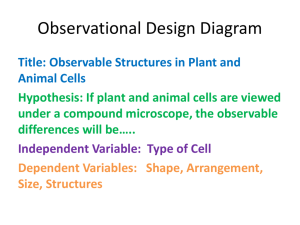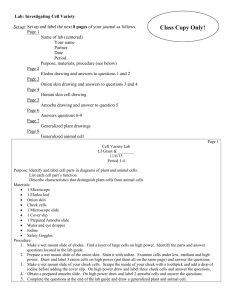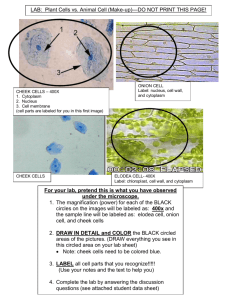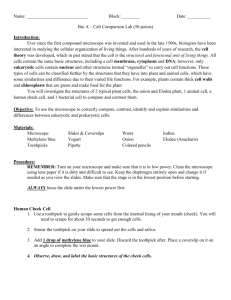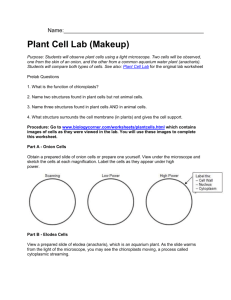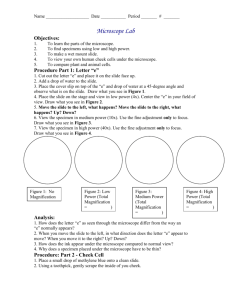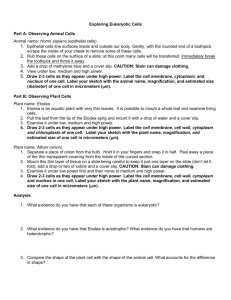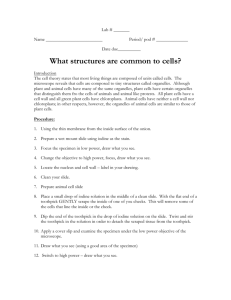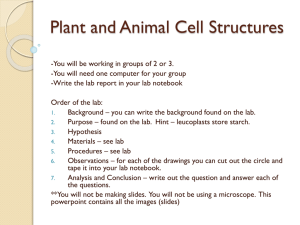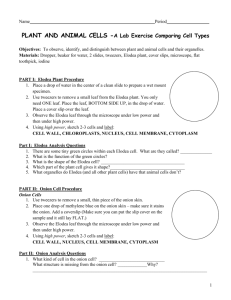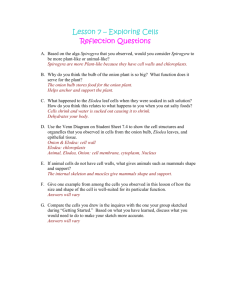Cell Size Lab: Cheek, Onion, Elodea Cell Comparison
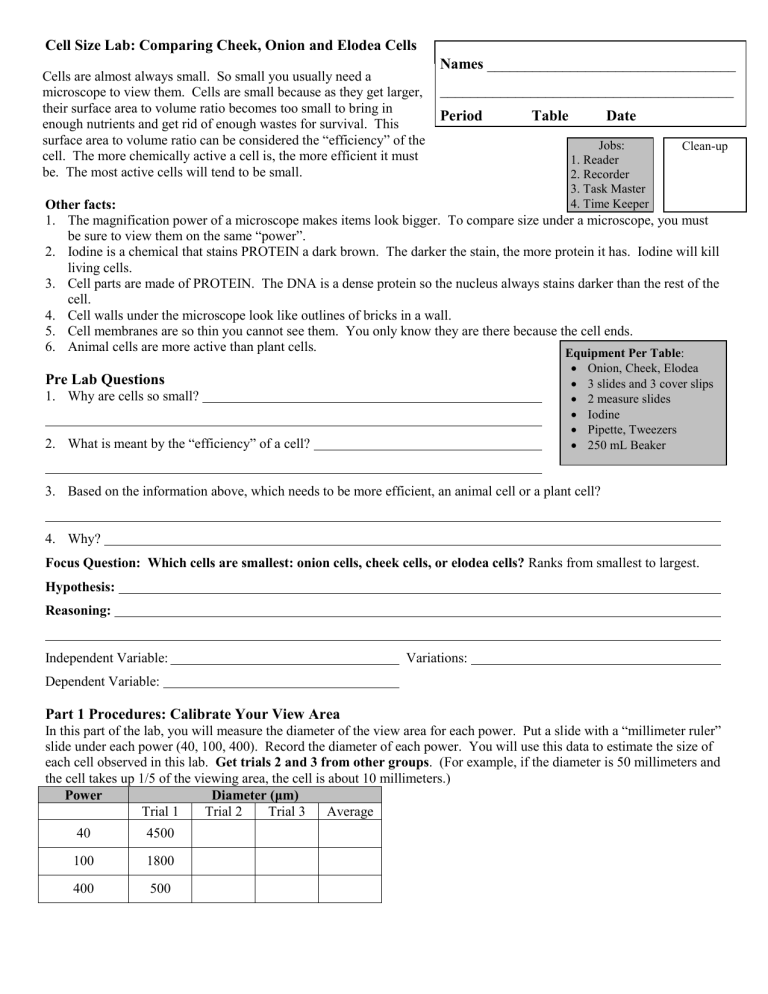
Cell Size Lab: Comparing Cheek, Onion and Elodea Cells
Cells are almost always small. So small you usually need a microscope to view them. Cells are small because as they get larger,
Names _________________________________
_______________________________________ their surface area to volume ratio becomes too small to bring in enough nutrients and get rid of enough wastes for survival. This surface area to volume ratio can be considered the “efficiency” of the cell. The more chemically active a cell is, the more efficient it must be. The most active cells will tend to be small.
Period Table Date
Jobs:
1. Reader
2. Recorder
3. Task Master
Clean-up
Other facts: 4. Time Keeper
1.
The magnification power of a microscope makes items look bigger. To compare size under a microscope, you must be sure to view them on the same “power”.
2.
Iodine is a chemical that stains PROTEIN a dark brown. The darker the stain, the more protein it has. Iodine will kill living cells.
3.
Cell parts are made of PROTEIN. The DNA is a dense protein so the nucleus always stains darker than the rest of the cell.
4.
Cell walls under the microscope look like outlines of bricks in a wall.
5.
Cell membranes are so thin you cannot see them. You only know they are there because the cell ends.
6.
Animal cells are more active than plant cells.
Pre Lab Questions
1.
2.
Why are cells so small?
What is meant by the “efficiency” of a cell?
Equipment Per Table :
Onion, Cheek, Elodea
3 slides and 3 cover slips
2 measure slides
Iodine
Pipette, Tweezers
250 mL Beaker
3.
Based on the information above, which needs to be more efficient, an animal cell or a plant cell?
4.
Why?
Focus Question: Which cells are smallest: onion cells, cheek cells, or elodea cells?
Ranks from smallest to largest.
Hypothesis:
Reasoning:
Independent Variable: Variations:
Dependent Variable:
Part 1 Procedures: Calibrate Your View Area
In this part of the lab, you will measure the diameter of the view area for each power. Put a slide with a “millimeter ruler” slide under each power (40, 100, 400). Record the diameter of each power. You will use this data to estimate the size of each cell observed in this lab. Get trials 2 and 3 from other groups . (For example, if the diameter is 50 millimeters and the cell takes up 1/5 of the viewing area, the cell is about 10 millimeters.)
Power Diameter (μm)
Trial 1 Trial 2 Trial 3 Average
40 4500
100 1800
400 500
Part 2 Procedures: Viewing
1.
You will be comparing 3 different cells: cheek, onion, and elodea.
2.
Remember to always start your viewing on low power . Then view on the highest power you can still see the whole cell.
3.
You must make a “wet mount” by placing a drop of water or iodine (do no add iodine to the elodea cells) on your slide, adding the cells, and then placing a cover slip over the specimen.
4.
Be sure you see all the parts on the chart below before you begin your drawings. Make your drawings to scale (draw what you see in the viewing area), calculate the size and record the magnification power.
Cheek Cells
1.
Put a drop of iodine on a slide. Gently scrape the inside of your check with a flat toothpick. Stir the invisible cells into the drop of iodine on the slide. If you see something on the toothpick after the scraping, you did something wrong. Since cells are microscopic, you should not be able to see them!
2.
View the cells on low power and move up to high power.
3.
Measure the size of the cell on high power.
Onion Cells
1.
of cells is NOT folded when you place it on the slide.
Collect the onion cells by carefully removing the inner lining of an onion piece. Be sure the thin sheet
2.
Add one drop of iodine to the cell and place a cover slip over it.
3.
View the cells on low power and move up to high power.
4.
Measure the size of the cell on high power.
Elodea Cells
1.
Collect the elodea cells by placing one leaf on the slide and covering it with a drop of water and the cover slip. DO NOT USE IODINE BECAUSE IT
WILL KILL THE CELL.
2.
view the cells on low power and move up to high power.
3.
Measure the size of the cell on high power
Data/Observations
A. Draw each of the cells using the following steps:
1.
In the circles below, write the power you find with the best view for each cell (usually high-
400x).
2.
Draw exactly what you see to the scale of the circle you are viewing.
3.
Record the estimated size of the cell.
B. Complete the data table. Get trials 2 and 3 from other groups.
Type of Cell
Trials
Cheek Cells
Onion Cells
Elodea Cells
1
Cell Size ( μ m)
2 3 Avg.
Cell Type: __________________ Cell Type: __________________ Cell Type: __________________
Magnification Power: _________ Magnification Power: _________ Magnification Power: _________
Graphs: Graph the trials and averages of the cell size data on your own paper.(use Excel!!)
Analysis: In Part C, relate the differences in size between plant and animal cells.
Conclusion: Describe what you learned in this lab about cell size.
